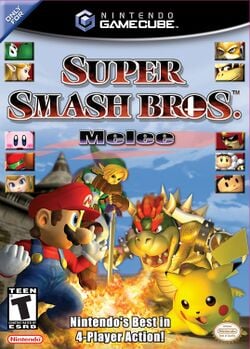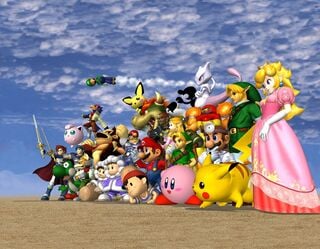Super Smash Bros. Melee: Difference between revisions
(→Modes: Too big!) |
(All must be without that caption.) |
||
| Line 143: | Line 143: | ||
*[[Classic Mode]] | *[[Classic Mode]] | ||
*[[Adventure Mode]] | *[[Adventure Mode]] | ||
*[[All-Star Mode]] | *[[All-Star Mode]] | ||
*[[Event mode|Event Match]] | *[[Event mode|Event Match]] | ||
*[[Stadium]] | *[[Stadium]] | ||
Revision as of 19:18, September 27, 2011
| Super Smash Bros. Melee | |
|---|---|

| |
| Developer(s) | HAL Laboratory |
| Publisher(s) | Nintendo |
| Designer(s) | Masahiro Sakurai |
| Released | |
| Genre(s) | Fighting game |
| Mode(s) | Single-player, Multiplayer (2-4) |
| Ratings | ESRB: T ELSPA: 11+ ELSPA: 3+ (re-rating) PEGI: 3+ OFLC: G8+ |
| Platform(s) | Nintendo GameCube |
| Media | 1 GameCube Game Disc |
| System requirements | 11 blocks of memory (an additional 2 or more blocks are needed for each snapshot saved) |
- "Melee" redirects here. For the game mode, see Versus Mode.
Super Smash Bros. Melee, known in Japan as Dairantou* Smash Brothers DX** (大乱闘 スマッシュ ブラザーズDX, Dairantō Sumasshu Burazāzu Dī Ekkusu), and often shortened to "SSBM" or "Melee", is a 3-D on a 2-D plane fighting game for the Nintendo GameCube. It was released in late 2001 in America and Japan, shortly after GameCube's launch, and early 2002 in Europe. It is the second game in the series, following Super Smash Bros..
Like Super Smash Bros., its predecessor, Melee features gameplay unique from that of other fighting games. Compared to characters in other fighting games, Melee characters have simple movesets and lack complicated button inputs and lengthy natural combos. Instead Melee emphasizes movement and ringouts. Indeed, edge-guarding in Melee takes on much more significance than it does in most other games due to copious mid-air jumps and other methods of reaching the edge unfettered.
* Dairantou = Great Fray
**DX = Deluxe
Intro
<youtube>56P3-TwuRBo</youtube>
Characters
The cast of 25 playable characters, 26 includng Zelda's alter ego Sheik, includes all twelve characters from Super Smash Bros. and thirteen newcomers. Of these, fourteen are available from the start of play, including all the "veteran" characters bar Luigi and Jigglypuff.
Of the new characters, the greatest number are from the The Legend of Zelda universe if Zelda/Sheik are counted as two characters to go with Ganondorf and Young Link; although the Mario series also takes three new character slots for Bowser, Princess Peach and Dr. Mario added. On top of these, two universes add two characters each, with the Fire Emblem series making its Smash Bros. debut with Marth & Roy; and the Pokémon universe adding Mewtwo & Pichu to its two existing characters. The three other characters added are Falco, a second character from the Star Fox series, and Mr. Game & Watch & the Ice Climbers from two highly venerable Nintendo series.
Starter characters
- File:MarioSymbol.png Bowser
- File:FZeroSymbol.png Captain Falcon
- File:DKSymbol.png Donkey Kong
- File:StarFoxSymbol.png Fox
- File:IceClimbersSymbol.png Ice Climbers
- File:KirbySymbol.png Kirby
- File:ZeldaSymbol.png Link
- File:MarioSymbol.png Mario
- File:EarthboundSymbol.png Ness
- File:PokemonSymbol.png Pikachu
- File:MarioSymbol.png Peach
- File:MetroidSymbol.png Samus
- File:YoshiSymbol.png Yoshi
- File:ZeldaSymbol.png Zelda/Sheik
Unlockable characters
- File:MarioSymbol.png Dr. Mario
- File:StarFoxSymbol.png Falco
- File:ZeldaSymbol.png Ganondorf
- File:PokemonSymbol.png Jigglypuff
- File:MarioSymbol.png Luigi
- File:FireEmblemSymbol.png Marth
- File:PokemonSymbol.png Mewtwo
- File:Game&WatchSymbol.png Mr. Game & Watch
- File:PokemonSymbol.png Pichu
- File:FireEmblemSymbol.png Roy
- File:ZeldaSymbol.png Young Link
Non-Playable Characters
- File:SmashBrosSymbol.png Giga Bowser (With action replay only)
- File:SmashBrosSymbol.png Master Hand (Except by glitch)
- File:SmashBrosSymbol.png Crazy Hand (With action replay only)
- File:SmashBrosSymbol.png Sandbag
- File:SmashBrosSymbol.png Fighting Wire Frames
Stages
There are eighteen starter stages and eleven more which can be unlocked.
Default stages
- File:MetroidSymbol.png Brinstar*
- File:StarFoxSymbol.png Corneria*
- File:KirbySymbol.png Fountain of Dreams
- File:ZeldaSymbol.png Great Bay
- File:KirbySymbol.png Green Greens*
- File:IceClimbersSymbol.png Icicle Mountain
- File:DKSymbol.png Jungle Japes*
- File:MarioSymbol.png Kingdom
- File:DKSymbol.png Kongo Jungle
- File:FZeroSymbol.png Mute City
- File:EarthboundSymbol.png Onett*
- File:PokemonSymbol.png Pokémon Stadium*
- File:MarioSymbol.png Princess Peach's Castle
- File:MarioSymbol.png Rainbow Cruise*
- File:ZeldaSymbol.png Temple*
- File:StarFoxSymbol.png Venom
- File:YoshiSymbol.png Yoshi's Island*
- File:YoshiSymbol.png Yoshi's Story
Unlockable stages
- File:SmashBrosSymbol.png Battlefield
- File:FZeroSymbol.png Big Blue*
- File:MetroidSymbol.png Brinstar Depths
- File:KirbySymbol.png Dream Land**
- File:SmashBrosSymbol.png Final Destination
- File:Game&WatchSymbol.png Flat Zone
- File:EarthboundSymbol.png Fourside
- File:MarioSymbol.png Kingdom II
- File:DKSymbol.png Kongo Jungle**
- File:PokemonSymbol.png Poké Floats
- File:YoshiSymbol.png Yoshi's Island**
* stages return in Super Smash Bros. Brawl.
** stages return from Super Smash Bros..
Single-Player stages
These stages cannot be unlocked, and can only be played under certain circumstances (or if the game is hacked).
- Target Test Stages
- Trophy Collector
- Race to the Finish
- Mushroom Kingdom Adventure
- Underground Maze
- Brinstar Escape Shaft
- F-Zero Grand Prix
- Rest Station
- Home-Run Stadium
- Majora's Mask
- Goomba
- Entei
Debug-Only Stages
These stages can only be used when the game is hacked. Some are functional, most are not.
Functional
- Test
- Zelda/Sheik's Target Test Stage
Non-Functional
* Can be activated with other hacks, but not Debug Mode.
Modes
1-Player
Multi-player
Action Replay
Unlockables
The game features several points to be unlocked, most of which include the trophies, unlockable characters and stages. Some of them are unlocked by a special way, like achieving a certain distance on the Home-Run Contest, while others are obtained by the Lottery. For a full list, see Complete Melee Unlockables.
Reception
| Melee reviews | |
|---|---|
| Publication | Score |
| Eurogamer | 10/10[1] |
| GameSpot | 8.9/10[2] |
| IGN | 9.6/10[3] |
| Nintendo Power | 5/5 [4][5] |
| Compilations of multiple reviews | |
| Metacritic | 92/100[4] |
| Game Rankings | 90.30%[5] |
Melee was well-received in many quarters and is the GameCube's top-selling game. More than seven-million copies of Melee were sold as of March 10, 2008.
Changes from the original
While Melee mainly follows the same formula introduced in the original game by retaining most elements, several differences exist between the two games. The following list, while not all-inclusive, addresses several of the changes. Please note that this list does not include obvious changes, such as a different button scheme/controller and Melee-only characters and items.
- All characters have four special moves; veterans now have a new Side B move. In some cases (such as Link), the character's old Neutral B got moved to their Side B, with the newly added move becoming the Neutral B.
- The number of throws each character can perform has also been increased to four; all veterans now have an up throw and a down throw. Some forward or back throws have been changed to a character's up or down throw (Kirby's forward throw in SSB, for example, is his up throw in this game). A majority of the throws themselves have been decreased significantly in power and knockback, though some are great for comboing.
- While grabbing, characters can now pummel the opponent.
- The pacing of the game has been increased.
- The amount of hitstun a character suffers has decreased.
- The single-player Board the Platforms bonus game does not return.
- Air dodging, moonwalking, and sidestep dodging have been implemented.
- All characters can move while carrying a heavy item (albeit very slowly); in the original, this ability was exclusive to Donkey Kong. Donkey Kong is the fastest carrier, of course.
- Spikes are now Meteor Smashes and all have been changed to be slightly harder to perform. (All characters' meteor smashes now have starting lag unlike the original)
- Wall jumping has been implemented.
- Certain characters can now wall grapple using their Tether Recovery.
- Items can now be grabbed before coming to a complete stop; they can also be grabbed by a midair character.
- Smash Attacks can now be charged by holding the A button.
- Smash Attacks can now be executed immediately with the C-Stick. (Though, unable to be tilted, unless one tilts the control stick as the C stick is hit.)
- The Heart Container's healing power has been reduced to simply healing 100%, while the Maxim Tomato's effect was also reduced to 50%.
- On-Screen Appearances have been removed, focusing more on the game's concept of trophies coming to life.
- There is a selection of time for stocks.
- If one ends a game early, the statistics will not be saved.
- The angle at which the menus are seen can be tilted with the C-stick. Also, the player can press L or R to view another fighter when the game is paused.
- If a box is broken, or if the Party Ball activates, an enemy from the Mario, Zelda, or Ice Climbers series might pop out. The chances of this are slim.
Tournament play
SSBM is widely known for its large and intricate tournament scene. The generally accepted birth of the tournament scene was caused by the creation of the Tournament Go series. Recently, the tournament scene has been bolstered by grand-scale tournaments such as the MLG series.
The community has constructed a set of standard tournament rules to regulate tournament play. All matches are played with timed stock (usually four lives and eight minutes), with items turned off and restrictions on legal stages. These regulations are enacted to ensure that gameplay at the highest level remains fair and interesting.
Gallery
- PA 01125 012.jpg
Super Smash Bros. Melee Japanese box art
- 00031424.jpg
Super Smash Bros. Melee PAL box art
References
- ^ http://www.eurogamer.net/articles/r_ssbm_gc
- ^ http://uk.gamespot.com/gamecube/action/supersmashbrosmelee/
- ^ http://uk.cube.ign.com/articles/166/166387p1.html
- ^ a b http://www.metacritic.com/game/gamecube/super-smash-bros-melee
- ^ a b http://www.gamerankings.com/gamecube/516492-super-smash-bros-melee/index.html
